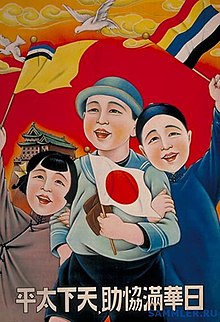
Back مهاجران احیای زمین بایر مانچوکوئو Persian Mandzsúriai japán telepesek Hungarian 満蒙開拓移民 Japanese Японская иммиграция в Маньчжурию Russian 满蒙开拓移民 Chinese
This article has multiple issues. Please help improve it or discuss these issues on the talk page. (Learn how and when to remove these messages)
|

The Japanese settlers in Manchuria were the Japanese immigrants who came to Manchuria after the Russo-Japanese War and settled in zones of Japanese interests (mostly in larger cities).

After the Japanese occupation (1931) and establishment of Manchukuo, huge crowds of Japanese agricultural pioneers settled in Manchuria. The first wave of the migration was a five-year trial emigration plan. Many had been young, land-poor farmers in Japan that were recruited by the Patriotic Youth Brigade to colonize new settlements in Manchukuo.[1] The Manchukuo government had seized great portions of these land through "price manipulation, coerced sales and forced evictions". Some Japanese settlers gained so much land that they could not farm it themselves and had to hire Chinese or Korean laborers for help, or even lease some of it back to its former Chinese owners, leading to uneasy, sometimes hostile relations between the groups.[1] These mass migration programs continued until the end of World War II.[2][3][4][5] By 1945, more than a million Japanese lived in Manchuria.
On August 10, 1945, one day after the Soviet Union declared war on Japan, the Japanese Army evacuated many families of officers and soldiers. On the retreat from Manchuria, bridges were destroyed and telegraph lines were cut. As many Japanese settlers became stranded in Manchuria, mass suicides were rampant.[6]
- ^ a b Spector, Ronald H. (2007). In the ruins of empire : the Japanese surrender and the battle for postwar Asia (1st ed.). New York. pp. 28–29. ISBN 9780375509155.
{{cite book}}: CS1 maint: location missing publisher (link) - ^ Japan in Manchuria: Agricultural Emigration in the Japanese Empire, 1932-1945 (November 2003), Japan in Manchuria: Agricultural Emigration in the Japanese Empire, 1932-1945. Arizona University
- ^ Sandra Wilson, “The ‘New Paradise’: Japanese Emigration to Manchuria in the 1930s and 1940s”, The International History Review, Vol. 17, No. 2, 1995, pp. 249-286.
- ^ Sandra Wilson, “The ‘New Paradise’: Japanese Emigration to Manchuria in the 1930s and 1940s”, The International History Review, Vol. 17, No. 2, 1995, pp. 274.
- ^ South Manchurian Railway Company, Fifth Report on Progress in Manchuria to 1936, South Manchurian Railway Company, Dairen, 1936 and Sixth Report on Progress in Manchuria to 1939, South Manchurian Railway Company, Dairen, 1939. p. 120.
- ^ Meyer, Michael. “https://Www.chinafile.com/Library/Excerpts/What-Happened-Settlers-Japanese-Army-Abandoned-China#:~:Text=On%20August%2010%2C%201945%2C%20the,in%20remote%20areas%E2%80%94from%20rescue.” China File.